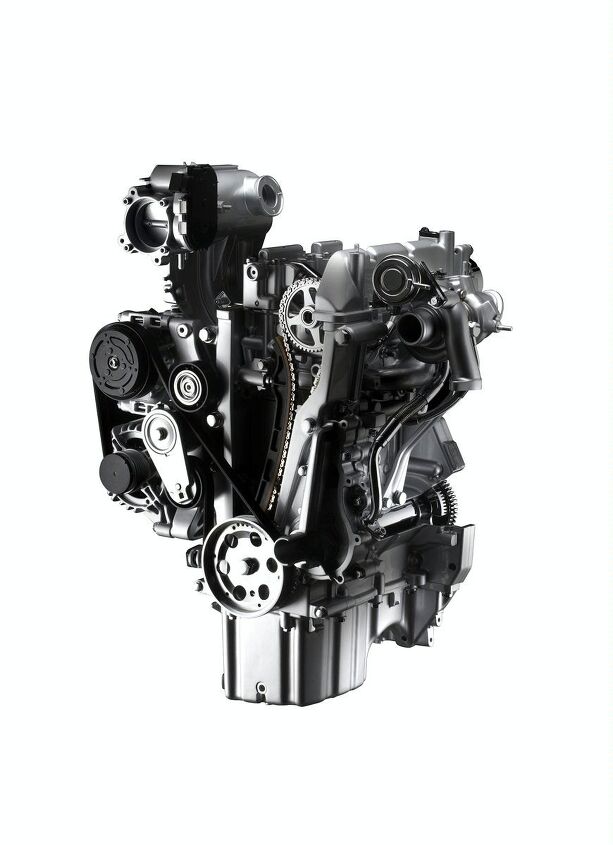Want To Save Gas? Get Rid Of Cylinders

There’s no replacement for displacement? Sure, as long as you own an oil well. If you want to save gas, there are three ways to do it:
- Make the car as light as can be (you can’t fool Newton.)
- Use the smallest amount of displacement you get get away with, and make it up with direct injection, a turbocharger, and computer smarts.
- Combine 1 with 2.
And what’s the easiest way to reduce displacement? Lose cylinders. That way, you also lose a lot of internal friction. If “Laufkultur” is part of your vocabulary, don’t read further, you’ll get sick. If you want to sick it to Big Oil, by all means, read on.
Automobilwoche [sub] writes that 3-cylinder engines are pretty much common, for instance at Volkswagen, in the Suzuki Alto und Splash, in the Opel Agila and the Nissan Pixo, just to name a few (in Europe.) Now, hats off to the next engineering feat: Two cylinders.
Fiat’s new 500 is going back to the future. The 1950 vintage original had two pots that turned half a liter of „displacement“ into 18 horses. The new engine has nothing in common, except for the two cylinders. The 875cc (that’s 53.39ci) MultiAir engine dispenses with a camshaft and has totally independent and variable valve control.
“That alone stands for 10 percent more power, 15 percent more torque and 10 percent better mileage,” says Thomas Kern of Fiat Frankfurt. The enginelet makes 85 horses out of its 875cc and brings the Fiat 500 to a top speed of 173 km/h (107 mph), while using only 4.1 liter / 100 km (57 mpg, non-EPA), while producing only 95 g of CO2 per km.
At VW, they are working on a two cylinder diesel that should bring even better mileage than the benchmark 100km (235 mpg – yes, you read that right, non EPA though.) The L1, a new generation of Piech’s 1 Liter Auto, is propelled by a two cylinder diesel with 0.8 liters displacement. In regular mode, it delivers 27 horses. Push the „Sport“ button, and power will jump to exhilarating 39 horses.
Sick already? We warned you.

Bertel Schmitt comes back to journalism after taking a 35 year break in advertising and marketing. He ran and owned advertising agencies in Duesseldorf, Germany, and New York City. Volkswagen A.G. was Bertel's most important corporate account. Schmitt's advertising and marketing career touched many corners of the industry with a special focus on automotive products and services. Since 2004, he lives in Japan and China with his wife <a href="http://www.tomokoandbertel.com"> Tomoko </a>. Bertel Schmitt is a founding board member of the <a href="http://www.offshoresuperseries.com"> Offshore Super Series </a>, an American offshore powerboat racing organization. He is co-owner of the racing team Typhoon.
More by Bertel Schmitt
Latest Car Reviews
Read moreLatest Product Reviews
Read moreRecent Comments
- Buickman I like it!
- JMII Hyundai Santa Cruz, which doesn't do "truck" things as well as the Maverick does.How so? I see this repeated often with no reference to exactly what it does better.As a Santa Cruz owner the only things the Mav does better is price on lower trims and fuel economy with the hybrid. The Mav's bed is a bit bigger but only when the SC has the roll-top bed cover, without this they are the same size. The Mav has an off road package and a towing package the SC lacks but these are just some parts differences. And even with the tow package the Hyundai is rated to tow 1,000lbs more then the Ford. The SC now has XRT trim that beefs up the looks if your into the off-roader vibe. As both vehicles are soft-roaders neither are rock crawling just because of some extra bits Ford tacked on.I'm still loving my SC (at 9k in mileage). I don't see any advantages to the Ford when you are looking at the medium to top end trims of both vehicles. If you want to save money and gas then the Ford becomes the right choice. You will get a cheaper interior but many are fine with this, especially if don't like the all touch controls on the SC. However this has been changed in the '25 models in which buttons and knobs have returned.
- Analoggrotto I'd feel proper silly staring at an LCD pretending to be real gauges.
- Gray gm should hang their wimpy logo on a strip mall next to Saul Goodman's office.
- 1995 SC No


































Comments
Join the conversation
Weight doesn't play a huge role in EPA highway economy, drag does. Weight DOES play a role in city economy and in the real world, where you have to accelerate that weight. - Cylinder count has nothing to do with engine longevity (except, of course, for harmonic imbalance... but that's another story). It's a misnomer to point at a hulking big agricultural engine and say that it's more durable because it has more cylinders. It's more durable because it's big, heavy, heavily-built and very low-revving. - Having driven 800cc cars, I can say that they're not horrible in terms of get-up-and-go. A turbocharged 40 hp 800cc diesel in a microcar is bound to be quicker than a 1.8 liter Chevrolet Cruze with that slurry 6-speed automatic.
Light weight, low horsepower = E30. I had a 1987 325 for a number of years. That car was the most fun I ever had on 4 wheels.